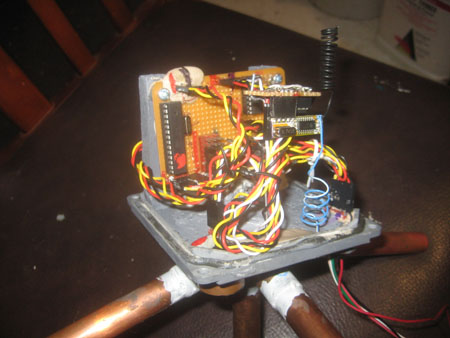|
|
|
Crocs as water bowls
Wednesday, July 15 2015
For weeks Gretchen has been talking about the urgent need to do something about Eleanor's long nails, which of course have continued to grow during that time. Today, though, we decided to actually do the job, which is never easy given how much Eleanor resists. Last time we tried giving her a valium, which sort of worked. This time, following some advice Gretchen had found online, we gave her 50 milligrams of diphenhydramine (Benadryl) about an hour before getting the clippers. At first we tried doing the clipping on the shaggy green carpet in the first floor office, but without any vertical surfaces to pin her against, it was hard to get her still enough. Also, Gretchen was cutting a little too close and nicking the quick, causing the nails to bleed. In addition to struggling, Eleanor was making horrible open-mouth groans and trying to bite the clippers. I carried her over to the couch, and we finished the job there. It's doable, but it's not pleasant. Fortunately, Eleanor didn't hold much of a grudge afterwards and immediately gobbled up the GreeniesTM Gretchen gave her as a reward for failing in her efforts (valiant though they were) to prevent the clipping.
At around 4:00pm I went a short distance down the Gullies Trail (a couple hundred feet shy of where I've been gathering wood lately) and bucked a couple thick (12 inch) pieces from largish skeletal trunk that had been lying on the ground for perhaps dozens of years. It had a little rot where it contacted the ground and a small amount of hollowness at its center (sorry, ant colony!), but otherwise it was sound and dry. Two of those pieces weren't quite enough to make a load (together they came to about 90 pounds), so I added a piece of Chestnut Oak that had migrated towards the house along the trail on occasions when I'd had empty arms and wanted to use them to do something useful. This load felt rather heavy and caused me to break into a heavy sweat despite unusually cool, dry air for this time of year. As I was trying to "land" the pack on a chunk of White Ash near the woodshed, I made a miscalculation and the pack fell over sideways, pulling me with it. I've had similar accidents before, but this time I banged my left elbow on a piece of wood, leaving a pair of gashes that produced almost no blood. Once I weighed the load (it was 124.5 pounds), I told Gretchen it was time for a swim over at the Duke of Luxemburg's pool. This was something she'd wanted to do all day. I hadn't been eager to get in the water until completing an arduous physical activity.
I'd shouldn't have worried; the Duke's pool was almost as warm as bathwater and it wasn't even too refreshing to get into it. It was more refreshing to take a shower. We'd ridden our bikes to the pool and Ramona had come along. She was so thirsty she attempted to drink the pool water (which is salty). Lacking a container, I filled my Crocs with water. Despite the holes around the sides, they could hold about three quarters of an inch if the toes were propped up somewhat, and this was good enough for Ramona.
I'd made myself some kratom tea today, and though it gave me a buzz that was conducive to productivity, it felt even less recreational than it had the time before. I'm worried that if I drink kratom tea more than once a week, it will end up being more of a maintenance drug like caffeine than something fun.
I mostly channeled that productivity into perfecting the reception of the AmbientWeather sensor receiver inside the barometric windvane. After much experimentation, I found that a wire attached to an empty through-hole next to the hole holding the antenna coil on the 433 MHz superhet receiver board dramatically and reliably improved reception of sensor broadcasts. Doing some research, I found a web page that suggested that a good length for a half of a 433 MHz dipole antenna was 182 millimeters. So I attached that length of wire to the hole and started receiving broadcasts from a sensor I'd placed a couple hundred feet away down the Farm Road. I wasn't going to be needing reception any better than that. Unfortunately, I didn't have room inside the barometric windvane's housing for a piece of wire that long, so I coiled it up in the manner of the existing antenna wire, though I pointed it downward instead of upward. It seemed to work acceptably like this.
I should mention that my recent work with AmbientWeather temperature sensors has revealed an interesting feature about the timing of their updates. I'd thought they would broadcast their temperatures every sixty seconds in the regular manner of Meade temperature sensors (which are so punctual that it seems the base station actually switches off its receiver circuit between expected transmissions to save power). But now that I'm carefully tracking the staleness of the AmbientWeather sensors' broadcasts, I see that the frequency of their broadcasts depends on their channel. Channel 1 seems to update every 52.5 seconds, Channel 2 updates every 56 seconds, Channel 3 updates every 58 seconds, Channel 4 updates every 60 seconds, Channel 5 updates every 66 seconds, and Channel 6 updates every 71 seconds. (I haven't tested channels 7 and 8.) I suspect the reason the sensors were engineered this way is so that if two sensors should start out broadcasting at precisely the same time, they will eventually go out of sync and the broadcast will get through when their timing diverges sufficiently. This is sort of the same reason Periodic Cicadas emerge from the ground after intervals of years measured in largish prime numbers.

Now that my barometric windvane is coming together as a finished piece of hardware (the software is still very much a work in progress), I wanted to give myself some expansion options before closing it up and perhaps beginning the calibration process (which will be a big part of making it into a functional windvane). Yesterday I'd added an additional weather-shielded four-pin passthrough at the bottom of the chassis so I could add either an external I2C device or something simple like a rain gauge. Today I decided that didn't give me enough options, so I added a five-pin passthrough connecting to two of the Atmega328's analog-in pins (A0 and A1), one of its digital pins (D2), five volts, and ground. Now the barometric windvane has three sets of passthroughs on its bottom: a five pin set for serial communications, a four-pin set for I2C, and now a five-pin set I'll refer to as "expansion."

The barometric windvane without its weather cover. The Atmega328 has a blob of red paint on it. Otherwise red is used to denote where positive voltage is provided, while black indicates ground. (Click to enlarge.)

You can see the added antenna wire here. It's the coil of thin blue wire harvested from an ethernet cable. (Click to enlarge.)
For linking purposes this article's URL is:
http://asecular.com/blog.php?150715 feedback
previous | next |


